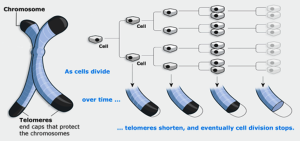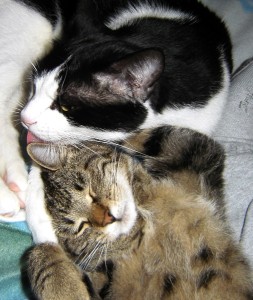This is the title of a Scientific American article, titled “Changing our DNA through mind control?”, that I read months ago and put away for when I had a bit of time/desire to do some research. Here’s the link to the article: http://goo.gl/TAkzK6
The gist is that mindfulness meditation (about which I’ve written a few posts in the past) is, and I quote, “associated with preserved telomere length. Telomeres are stretches of DNA that cap our chromosomes and help prevent chromosomal deterioration — biology professors often liken them to the plastic tips on shoelaces. Shortened telomeres aren’t known to cause a specific disease per se, but they do whither with age and are shorter in people with cancer, diabetes, heart disease and high stress levels. We want our telomeres intact.” (P.S. “whither with age?” Harrumph…!!!) 
Well, in spite of its unfortunate typo, this SA article inspired me to put on my research cap, after I discovered that telomeres are strongly involved in myeloma progression–short telomeres, to be more specific. So let’s have a look at some of the studies I’ve read or glanced at in PubMed in the past few days and try to figure out what’s going on…
A 2012 Spanish study published in the Journal of Cellular and Molecular Medicine suggests that MM cells maintain short telomeres for proliferation purposes: http://goo.gl/yhpsaj.
Excerpt: maintaining short telomeres is “a mechanism contributing to MM tumour cells expansion in the bone marrow.” These crappy malignant cells of ours manage to keep their telomeres right above the critical level, that is, the level under which they would eventually have to die. In other words, MM cells use short telomeres to stay alive as long as possible, thus avoiding the normal process of apoptosis, or cell death. As we know by now (I’ve written a bunch of posts about apoptosis…use the handy “Search” box to find ’em), apoptosis occurs on a regular basis in normal cells–as I understand it, their telomeres start getting shorter and shorter, and eventually the cells stop reproducing and die off…But myeloma cells want to live forever, so they have “devised” a way of keeping their telomeres above the critical “too short” level…Quite an extraordinary accomplishment, actually, when you think about it…
And it is in this study, ladies and gentlemen!, where I first read that one of the differences between MGUS and MM is that telomeres are shorter in MM patients.
There is more. And I quote, “in MM high telomerase activity and short telomere length defined a subgroup of patients with poor prognosis and shorter mean survival.”
A Translational Oncology study from 2013 depicts an even scarier scenario, depicting vile interactions between telomeres and myeloma cells: http://goo.gl/vGB2dD These researchers carried out a three-dimensional (3D) analysis of the telomeres obtained from blood and bone marrow samples of MGUS and MM patients, including relapsed MM patients…mostly in the IgG group. It’s an important study for us because it links shorter telomeres to progression from MGUS to MM.
Excerpt (my highlight): “This study showed changes in 3D nuclear architecture during disease progression from MGUS to MM, based on our findings of increased telomere attrition, resulting in shorter telomeres in MM, as well as in MMrel, compared to MGUS.” So this study reaches the same conclusion as the above-mentioned Spanish study.
Now, I don’t know if you are thinking of the same questions that popped into my mind as I was reading and trying to figure out all this stuff, but anyway, here’s one of ’em: wait a sec, if short telomeres are bad, would’t it be worse to have long ones, which theoretically have a longer life span?
I got my answer today (quelle coincidence!) in this Cancer Compass alert: http://goo.gl/VhljLV It’s easy to read, btw, so do have a look. Basically, it reports on a newly published study showing that “a pattern of change in DNA that may signal the development of cancer long before a standard diagnosis can be made.” And, drum roll, this pattern concerns our very own telomeres. Apparently, the “telomeres belonging to future cancer patients may shorten in length to such a degree that they resemble telomeres belonging to people 15 years older.” Bingo.
Connections. In order to stop progression, we need to have longer telomeres.
Okay, I think we’re done with telomeres for now. So let’s have a quick look at telomerase, which is also important in myeloma. In a nutshell, telomerase is an enzyme that helps prevent the shortening of telomeres, thus preventing a cell from aging. Easy peasy so far…
But what does this really mean for us? Well, the above-mentioned 2012 Spanish study (and there are others, not cited here), suggests that an increase in telomerase activity (or TA) helps MM cells survive. I had a look at a whole bunch of PubMed studies showing that MM cells have a hard time proliferating when telomerase activity is inhibited.
So, simply put: inhibition of TA is good.
In conclusion, we want longer telomeres and less TA activity in our MM cells.
And here’s the answer to another question that popped into my mind: yes, yes, yes, among the million other things it does, curcumin also inhibits telomerase activity. And it also apparently helps preserve telomere length (!), possibly even improve it. Wowsie.
According to this 2006 study, “curcumin inhibits telomerase activity in a dose and time-dependent manner“: http://goo.gl/Tcz5HJ. It inhibits TA, thus shortening telomeres, which means, as we have seen before, that the cancer cell stops reproducing itself and dies. I think it’s obvious, but I suppose I should point out that in this case it’s good for the telomeres to be shortened, because it means they are at death’s door. The study, carried out on a leukemia cell line, also points out that the existing synthetic telomerase inhibitors “are always highly toxic,” something that, as we well know, curcumin is not.
Another study, published in 2015, confirms that curcumin diminishes TA, leading to death of the cancer cell: http://goo.gl/eX5nHH In PuBMed there are currently 34 studies on the impact of curcumin on telomerase. Considering the fact that curcumin won’t make piles of money for anyone, that’s quite a good number, methinks.
As for other naturally-derived substances and their possible effect on telomere length and telomerase, well, I need more time to look into that…
A final note: I also read that stress is linked to shorter telomeres. And so is lifestyle. And those are my final serious thoughts for today! This afternoon I’m going off to play cards with my friends… 🙂





